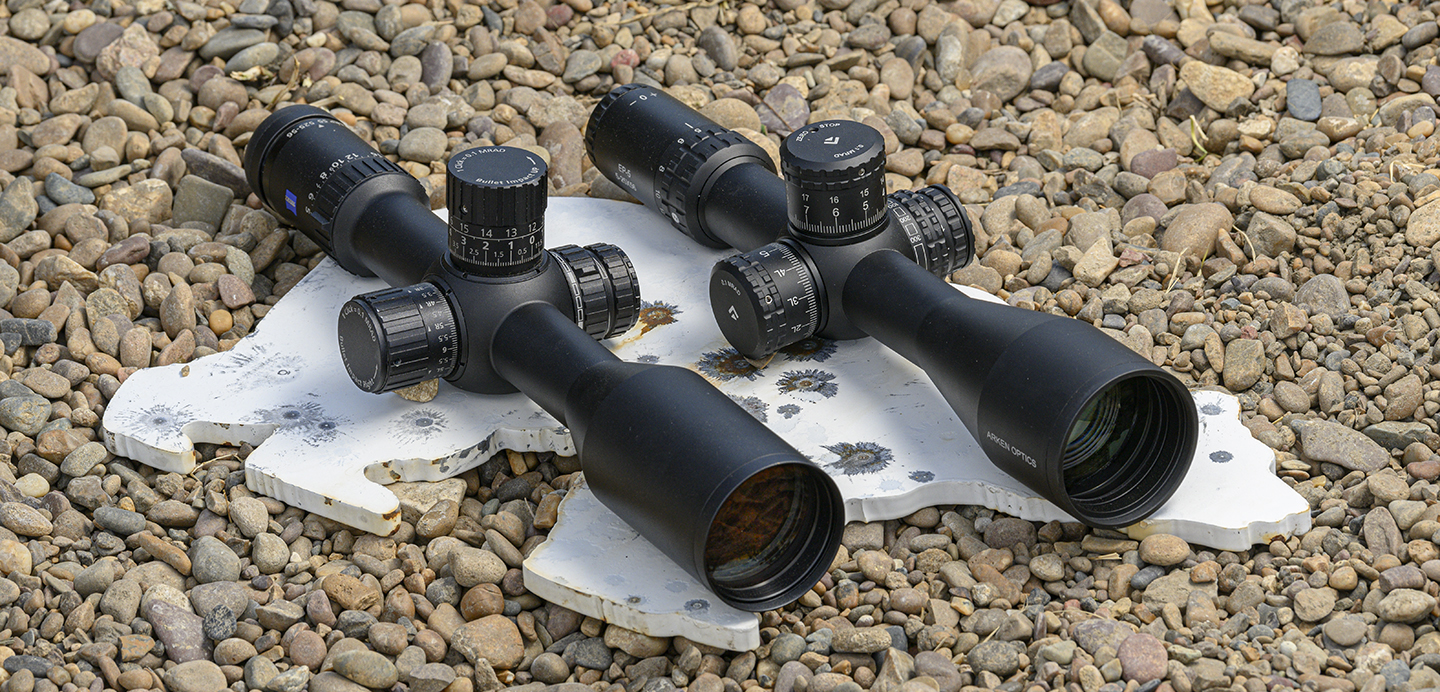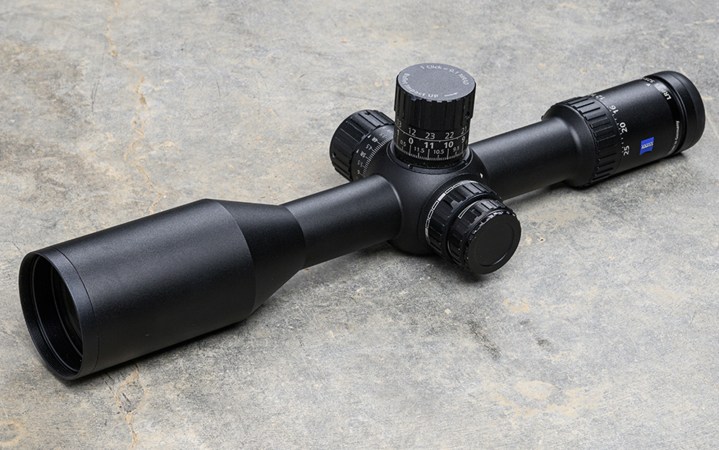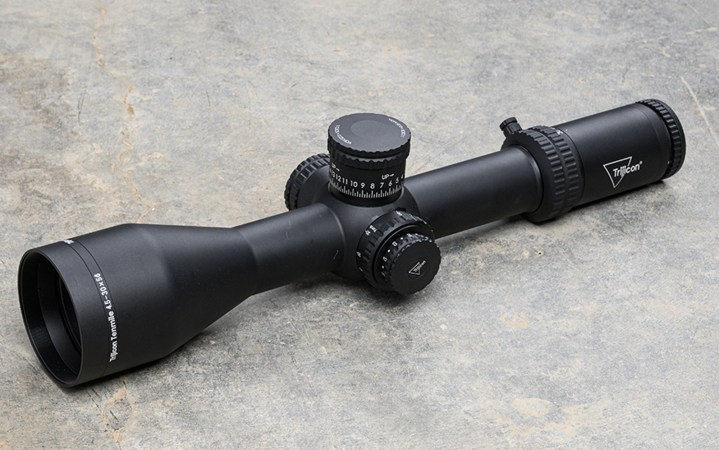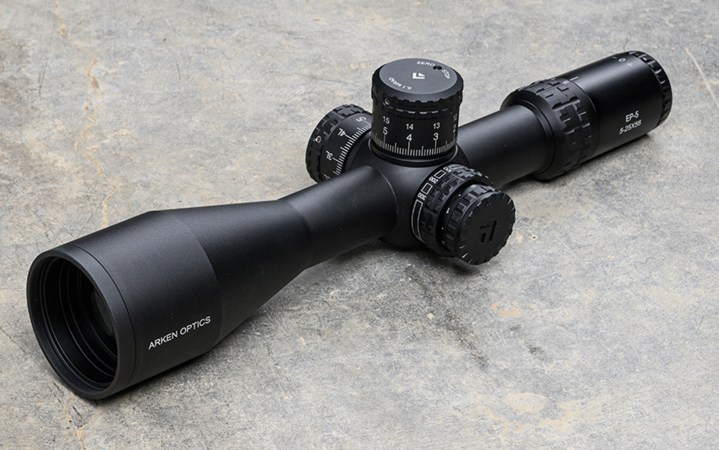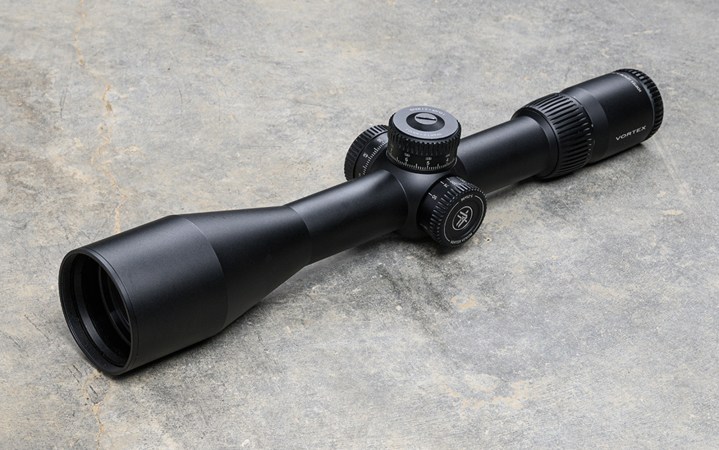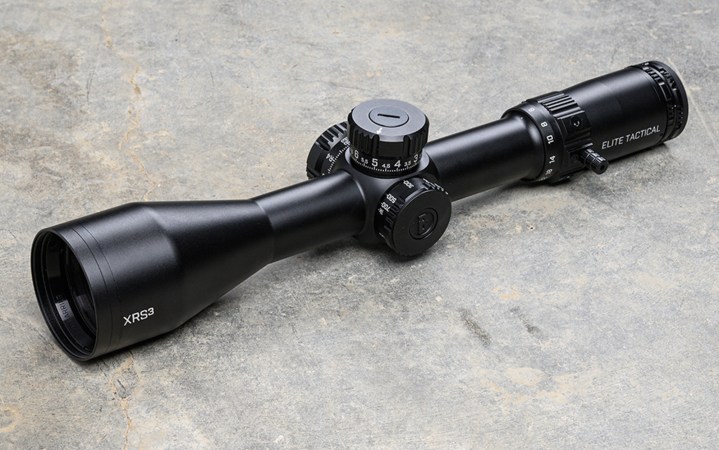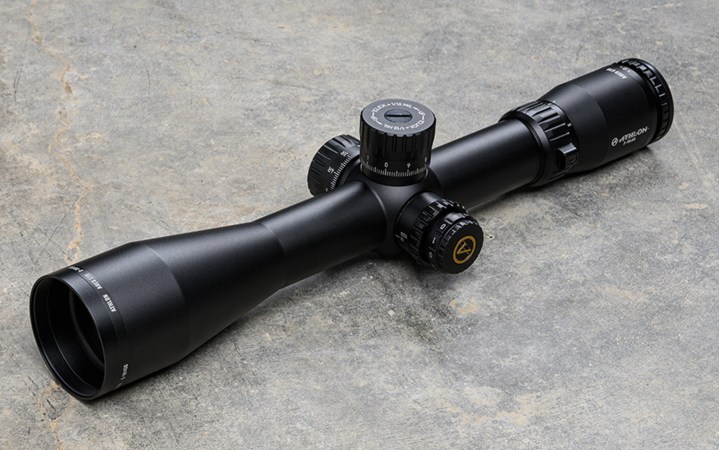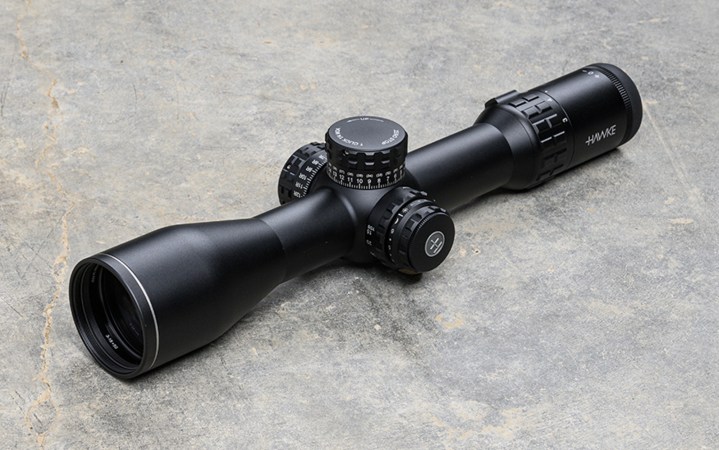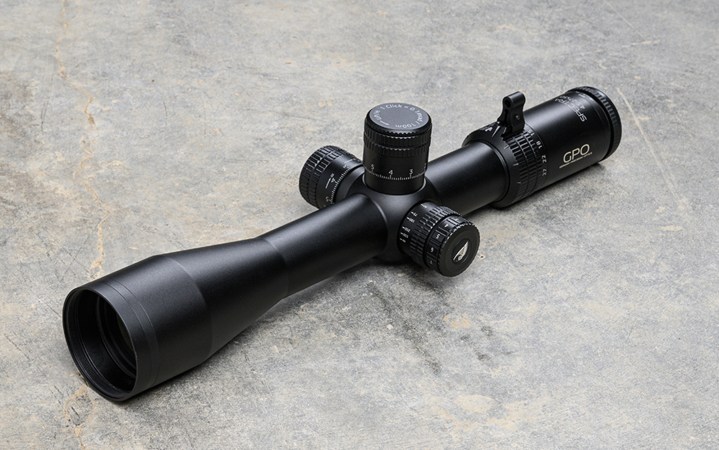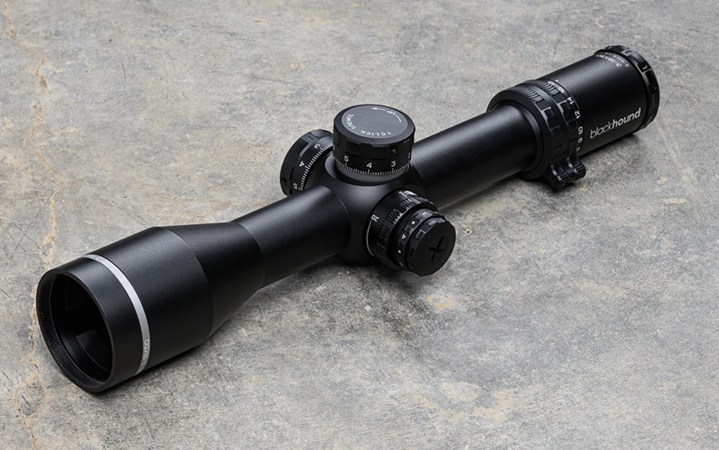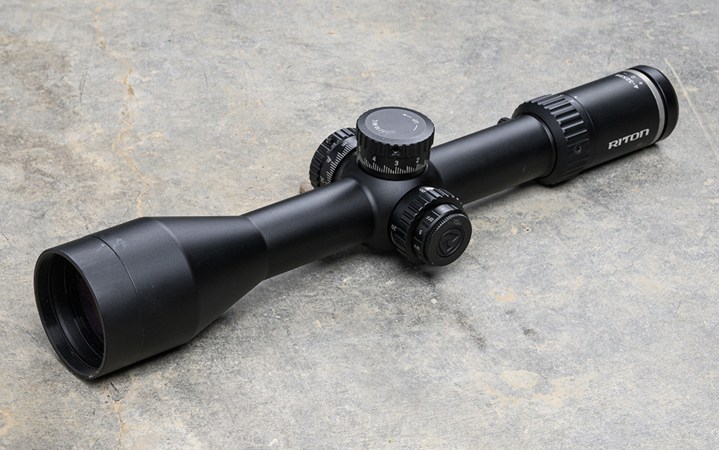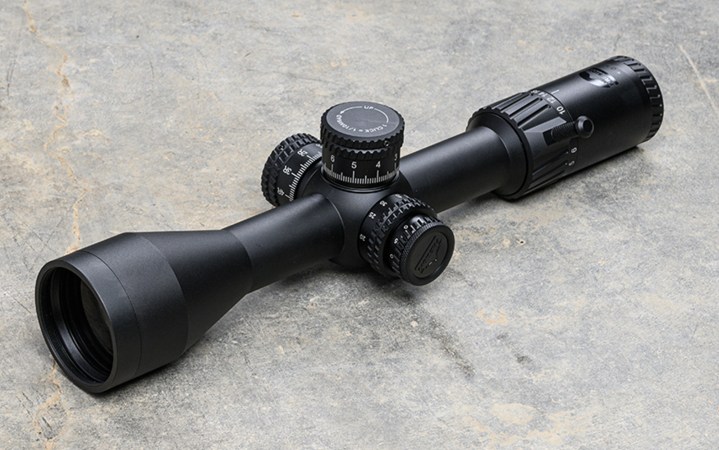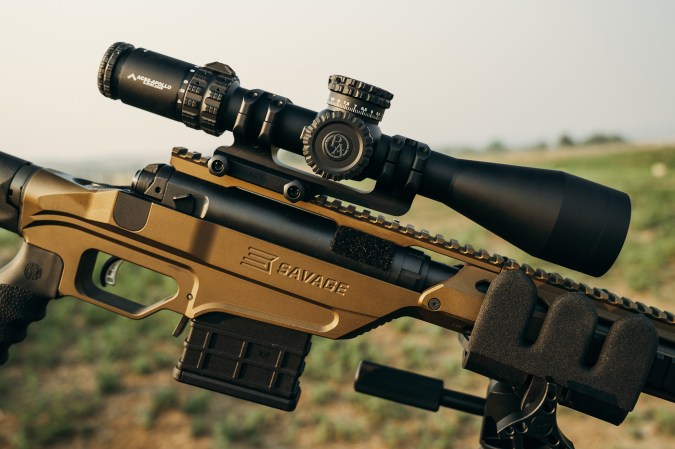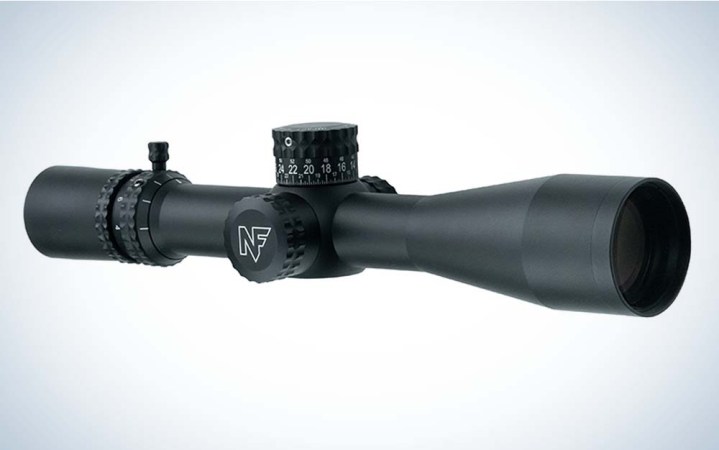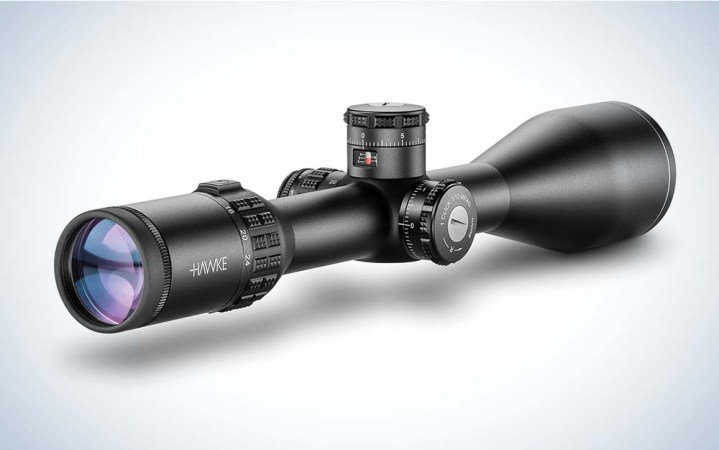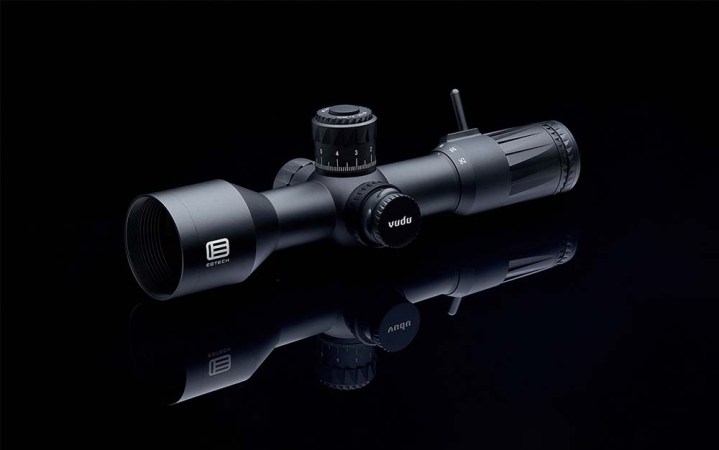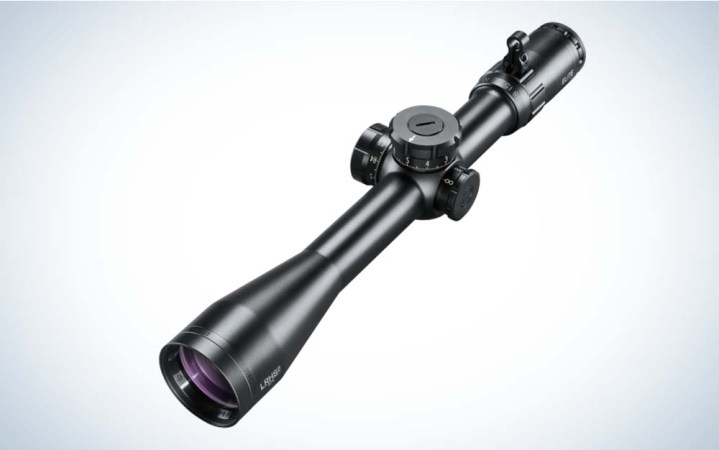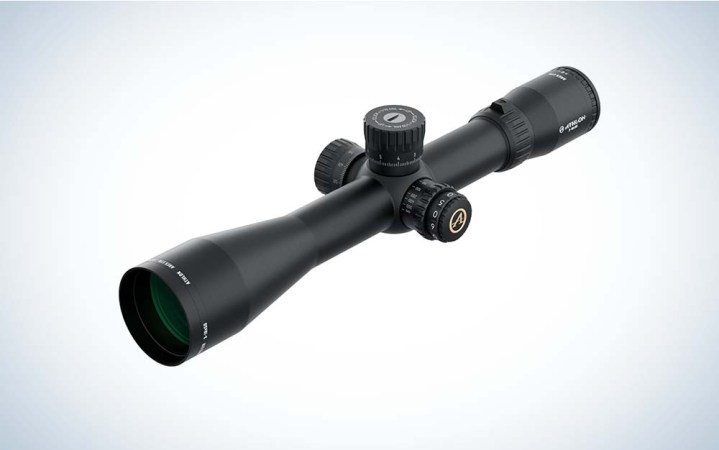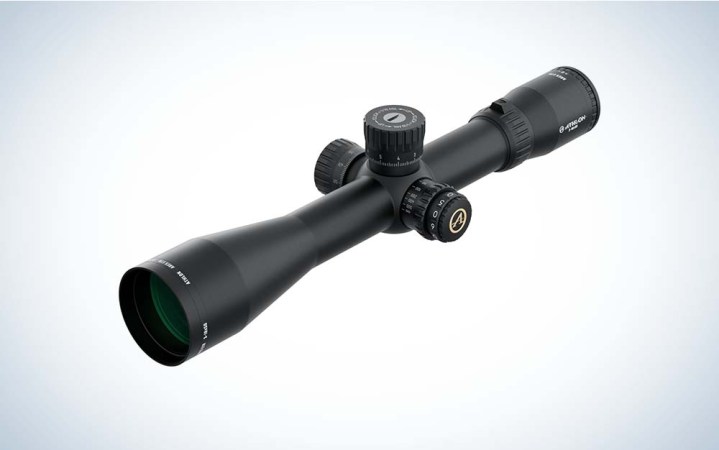We may earn revenue from the products available on this page and participate in affiliate programs. Learn More ›
Thankfully, the cookie-cutter precision rifle scope has been replaced with models that have various magnification ranges, tube sizes, reticle configurations, and retail prices. What we’re seeing in the long range rifle scopes—finally—is a maturing market, one that is starting to produce precision scopes for a wide range of shooting tasks and personal preferences.
We’re also seeing the establishment of a trend that started last year, with very affordable precision scopes taking market share from those venerable brands that are producing scopes that cost far more than the rifles they’re intended to be paired with. What all these scopes have in common are first-plane reticles, exposed tactical-style elevation turrets, and the ability to engage targets out to, and beyond, a mile. About those turrets. This is the first year we’ve seen brands pay full attention to overbuilding this most critical but failure-prone piece of a precisions scope. For the first time, I can say that every one of the scopes in this year’s test has turrets that turn with precision, repeatability, and tactile responsiveness. Some are simply better than others.
Note that these are all scopes entered in this year’s Outdoor Life Optics Test. They’re the best long range rifle scopes that were introduced to the market either in 2023 or late in 2021, so this is not a roundup of all precisions scopes on the market. The order in which these scopes are listed reflects their ranking in our annual test.
- Best Overall: Zeiss LRP S5 5-25×56
- Best High-Magnification: Trijicon Tenmile 4.5-30×56
- Best Budget: Arken EP5 5-25×56
- Best New Entry: Vortex Venom 5-25×56
- Most Innovative Reticle: Bushnell Elite Tactical XRS3 6-36×56
- Athlon Ares ETR UHD 3-18×50
- Best Lightweight: Hawke Frontier 34 FFP 3-18×50
- Best for Elk: GPO Spectra 6x 4.5-27×50
- Best New Brand: Blackhound Evolve 3-18×50
- Riton X7 Conquer 4-32×56
- Best Entry-Level: Sightmark Presidio 3-18×50
Best Overall: Zeiss LRP S5 5-25×56
Best Overall
Zeiss LRP S5 5-25×56
Why It Made The Cut
Built around premium glass and a reticle designed for Precision Rifle Series steel-target competitions, the S5 has the best turrets and most adjustment range in the class.
Key Features
- Weight: 36.3 ounces
- Magnification: 5-25-power
- Objective Lens Diameter: 56mm
- Tube Diameter: 34mm
- Reticle Type: Either ZF, MRAD, or MOA in first plane
- Turrets: Either .1 MRAD or .25 MOA click values
- Illumination: Yes, 10 intensity levels
- Parallax: Yes
Pros
- Available in MOA or MRAD versions
- European style
- Excellent glass and coatings
- Precise parallax focus
- Most positive turrets in our test
- Whopping 40.7 MRAD or 140 MOA internal adjustment
- Daylight-bright illumination
Cons
- Very heavy
- Expensive
Product Description
Zeiss invested years in this product, missing the first wave of precision scopes in order to deliver a competition optic worth the wait. Let’s first dispense with what this scope is not. It is not a walk-about hunting scope or one that you’re going to swap from rifle to rifle. It’s not cheap. Instead, it’s a big, serious, investment-grade optic that’s engineered to engage targets from middling distances to way out there and you can expect to see it winning the biggest competitions over the next years.
The LRP S5, also available in a 3-18×50 version, easily won the top award in this year’s OL optics test, taking top spots in both the resolution and low-light portions of the test. But what wowed testers were the features built for both dialing and holding for distant targets. The illuminated ZF reticle is available in either MOA or MRAD versions. The MRAD version incorporates a tree-style structure with abundant elevation and windage references without seeming cluttered. The MOA version is more of a hash-style, with references on the main stadia. Both are fast, precise, and simple. In keeping with those superlatives, the scope has a crazy amount of internal adjustment in the 34mm tube, 40.7 MRAD (140 MOA) of elevation travel and 24 MRAD (60 MOA) of windage adjustment. That means you can engage targets from inside 100 yards out to 1,500 yards simply by holding on the reticle’s center aiming point and dialing your aiming solution.
The beefy turrets, which can be re-zeroed in the field without tools, turn with smart, positive clicks, but have the added benefit of a deeper detent every 5 MOA (or 1 MIL) to give shooters instant feedback as they dial. In all, it’s the best all-around scope for PRS and NRL shoots that we’ve seen yet and the unanimous choice for this year’s best-in-class precision scope.
Read our full review of the Zeiss LRP S5 to learn more.
Best High-Magnification: Trijicon Tenmile 4.5-30×56
Best High-Magnification
Trijicon Tenmile 4.5-30×56
Why It Made The Cut
A big, serious precision rifle scope, the Tenmile has a wide magnification range, sweet turrets, and a versatile first-plane competition reticle.
Key Features
- Weight: 36.0 ounces
- Magnification: 4.5-30-power
- Objective Lens Diameter: 56mm
- Tube Diameter: 34mm
- Reticle Type: MOA or MRAD Precision Tree in first plane
- Turrets: .25 MOA or .1 MRAD click values
- Illumination: Yes, red and green
- Parallax: Yes
Pros
- Huge magnification range
- Precise first plane reticle
- Exposed re-zeroable elevation turret
- Capped windage turret
- Re-zeroable and zero-stoppable turrets
- Both red and green illumination
- 100 MOA/29.1 elevation adjustment range
Cons
- Very heavy
- Illumination could be brighter
Product Description
Had the Zeiss LRP S5 not been in the test, the Trijicon would have won top billing. As it is, this is one of the best long range rifle scopes for shooters who want many of the same features as the Zeiss at about $1,000 less. The Tenmile is available in both MOA and MRAD versions with the same excellent turrets and other controls.
Testers noted that the Trijicon’s glass is every bit as good as that of the Zeiss, and praised the responsive turrets and overall handling. Some testers loved the green and red illumination, but a consensus opinion is that the highest intensities of either color isn’t quite enough to use in full daylight. The Tenmile has a monster magnification range, but testers felt like the reticle references weren’t useful until about 7X. The internal adjustment range inside the 34mm tube is among the best in the class, but far below that of the Zeiss.
On the plus side, the Trijicon has better mounting dimensions and the turrets can be swapped out for custom dials if you want load-specific controls. With those attributes in mind, the Trijicon earned higher versatility scores than the single-purpose Zeiss.
Best Budget: Arken EP5 5-25×56
Best Budget
Arken EP5 5-25×56
Why It Made The Cut
The EP5 contains a ton of value inside a hard-wearing precision scope with competition reticle, beefy turrets, illumination, and tight focus.
Key Features
- Weight: 39.2 ounces
- Magnification: 5-25-power
- Objective Lens Diameter: 56mm
- Tube Diameter: 34mm
- Reticle Type: MIL or MOA-based VPR in first plane
- Turrets: .1 MRAD/.25 MOA
- Illumination: Yes, red center cross
- Parallax: Yes
Pros
- Extremely affordable
- Available in either MOA or MRAD versions
- Excellent glass for the price
- Useful target reticle
- Zero-stoppable turret
- Good turret indexing
- Fully transferable lifetime warranty
Cons
- Flinty turret clicks
- Questionable durability
Product Description
How Arken can deliver this amount of performance at such a low price is astonishing. The company dropped its price by $100 over the course of our 3-month evaluation to make it even more affordable.
The EP5 has just about every feature a competition steel-ringer is looking for: excellent first-plane reticle that’s available in either MOA or MRAD configurations, good turrets, industry-standard magnification range, decent illumination, and side focus that squeezed down to 25 yards, making this a decent option for rimfire competition shoots.
The Japanese glass is better than many of its budget-class peers, and the tree-style dot/hash reticle has all the right attributes for precision work, though it’s not especially visible until about 9X and the center aiming point gets lost in a cluttered background. We like the re-zeroable and zero-stoppable turrets, though they don’t feel as positive as others in the test.
But the EP5 delivers so much utility for such a little price that it’s our hands-down recommendation for an entry-level precision scope and the consensus winner of our Great Buy award.
Best New Entry: Vortex Venom 5-25×56
Best New Entry
Vortex Venom 5-25×56
Why It Made The Cut
With great controls, this very useful competition reticle sells for an appealing price.
Key Features
- Weight: 35 ounces
- Magnification: 5-25-power
- Objective Lens Diameter: 56mm
- Tube Diameter: 34mm
- Reticle Type: Tree-style in first focal plane
- Turrets: .1 MIL/.25 MOA
- Illumination: No
- Parallax: Yes, 15 yards to infinity
Pros
- Available in either MOA or MRAD controls
- 38 MOA (11 MIL) elevation references
- Excellent warranty
- Integrated throw lever
- Wide parallax range
- Excellent zero stop
Cons
- Underwhelming glass
- No illumination
Product Description
Vortex has owned the high-end precision scope market since its Razor HD line came along. The company has since lost market share to other brands, but the Venom is a chance to appeal to new shooters looking for an affordable precision scope. It does that with an excellent controls and a very useful reticle in either MOA or MRAD geometry. We loved the 15-yard close focus, a feature that makes this an appealing option for rimfire precision matches. And we liked the crisp turrets (with somewhat limited internal adjustment range, compared to peers), though they turned with a sort of tinny feel.
The Venom would have scored higher if it had a better quality of glass and more reliable controls. Our sample shipped with a hinky focus knob that went in and out of focus at far distances. But the zero stop is one of the best in the business—at any price—and the magnification ring turned with smooth authority. Competition shooters will love the .1 MIL subtensions on the reticle, another rarity at this price point. Combined with Vortex’s excellent warranty, the Venom offers a tremendous amount of value at this price.
Most Innovative Reticle: Bushnell Elite Tactical XRS3 6-36×56
Most Innovative Reticle
Bushnell Elite Tactical XRS3 6-36×56
Why It Made The Cut
A battle-hardened scope with an excellent eyebox and massive magnification, this precision reticle has a remarkable amount of references.
Key Features
- Weight: 38.9 ounces
- Magnification: 6-36-power
- Objective Lens Diameter: 56mm
- Tube Diameter: 34mm
- Reticle Type: Hash-and-dot style in first plane
- Turrets: .1 MIL
- Illumination: No
- Parallax: Yes, 50 yards to infinity
Pros
- Huge magnification range
- Multi-position “ThrowHammer”
- Competition EQL reticle
- RevLimiter zero stop
- Expansive eyebox
Cons
- No illumination
- Reticle appears busy to new shooters
Product Description
Bushnell has updated its venerable Elite Tactical scope with a brand new proprietary reticle that looks a little like reticles from Horus. The EQL reticle is built for competition shooters, arranged in what’s called a 2/10 MRAD grid. It features a floating-dot aiming point, a bisected hash system for elevation holds, multiple ranging and mover references, and floating half-value dots. Beginning shooters, or those who like an uncluttered image, will complain that this EQL reticle is too busy; but the competition shooters on our test panel loved the amount and arrangement of references.
The Elite Tactical’s glass and coatings are excellent, and the Bushnell produced one of the best low-light marks in the test, partly because it lacks illumination and the extra lens element illumination requires. The team was split on the whopper magnification, but ultimately concluded that the image is so degraded above 30X that they would limit utility to 25 or 28X. The reticle’s sweet spot is about 15X. Other favorite features: the very visible turret indexing, the solid RevLimiter zero stop, and the throw lever on the magnification ring. Without that lever, the magnification ring is maddeningly hard to turn.
Athlon Ares ETR UHD 3-18×50
Athlon Ares ETR UHD 3-18×50
Why It Made The Cut
While a great scope for shooters who engage targets at middle distances, it’s also a wonderful rimfire scope.
Key Features
- Weight: 31.4 ounces
- Magnification Range: 3-18-power
- Objective Lens Diameter: 50mm
- Tube Diameter: 34mm
- Turret Click Values: .25 MOA/.1 MIL
- Reticle Focal Plane: Both MOA and MIL options in first plane
- Illuminated Reticle: Yes
Pros
- 10-yard close focus
- Available in both MIL and MOA models
- Respectable internal adjustment range
- 6-step illumination
Cons
- Disappointing glass
- Basic reticle
Product Description
The Ares ETR is a decent competition scope that does most of what precision shooters want: versatile reticle in first plane, good zero-stoppable turrets, and daylight-bright illumination. The test team was split on that reticle. Those who regularly shoot in PRS competitions wanted finer references; those who use first-plane reticles for hunting and mid-range target shooting thought the reticle’s open appearance was more versatile. The versatile shooters also love the modest magnification range of the Athlon; the more serious competition shooters wanted a little more mag.
The glass is okay, but we noticed some flaring and peripheral distortion at higher magnifications. But probably the greatest feature is the close-in parallax control which will appeal to rimfire shooters, but long-range shooters also noted that once you set the focus for 300 yards, images are sharp all the way out to 800 yards, a feature that minimizes focus fuss in the heat of competition.
Best Lightweight: Hawke Frontier 34 FFP 3-18×50
Best Lightweight
Hawke Frontier 34 FFP 3-18×50
Why It Made The Cut
The lightest scope in the precision field, this feature-rich optic is suited to a long range hunting rifle or a precision rimfire rifle.
Key Features
- Weight: 29.3 ounces
- Magnification: 3-18-power
- Objective Lens Diameter: 50mm
- Tube Diameter: 34mm
- Reticle Type: Pro Ext in either MOA or MIL
- Turrets: .25 MOA/.1 MIL
- Illumination: Yes, 11-step intensity
- Parallax: Yes
Pros
- Lightweight for class
- 15-yard close focus
- Huge internal adjustment range
- Daylight-bright illumination system
- Clear turret indexing
Cons
- Sloppy turrets
- Limited distance utility
Product Description
This is one of the few precision scopes that could have easily been entered in our versatile scope category, or optics that do double duty as hunting and target scopes. The Frontier’s light weight, modest magnification range, and wide focus range make it a good choice for a precision .22 or Western big-game rifle.
There’s even more versatility here. It’s available in either MOA or MRAD models, and the Pro Ext reticle has a ton of references—maybe too much for a beginning shooter, who might describe this as cluttered. But for shooters who understand the inverse horseshoe, the huge amount of elevation and decent amount of windage will place bullets using holdover and holdoff rather than dialing aiming solutions. For those who want to dial, the Frontier has a jaw-dropping amount of turret travel, 158 MOA (46 MIL) of elevation range.
Best for Elk: GPO Spectra 6x 4.5-27×50
Best for Elk
GPO Spectra 6x 4.5-27×50
Why It Made The Cut
A worthy cross-over target and hunting scope, this is a good choice for hunters who want first-plane reticle references to place long shots.
Key Features
- Weight: 29.1 ounces
- Magnification Range: 4.5-27-power
- Objective Lens Diameter: 50mm
- Tube Diameter: 34mm
- Turret Click Values: .1 MRAD
- Reticle Focal Plane: LR Pro in first plane
- Illuminated Reticle: Yes
Pros
- Infinitely adjustable illumination intensity
- Simple hash-style reticle
- Tool-less zero stop
- Close 25-yard parallax focus
- Lightweight for class
Cons
- Simple hash-style reticle
- Throw lever impedes bolt travel in some rifles
Product Description
Like the Hawke Frontier, the Spectra could have easily competed in our versatile scope category. It’s a decent crossover hunting and target scope, with attributes that do decent service in both categories, even if they’re a little lacking for hunting or precision target shooting alone. Consider the nicely illuminated reticle. It lacks references for the target shooters on our team, but the hunters among us like the simplicity and versatility. Shooters like the heft and durability; hunters thought the scope was too heavy and complicated for hard-core Western hunts.
The glass is very good. The infinitely adjustable illumination is very nicely done, and the 25-yard close focus brings targets into crisp focus no matter the distance. But with .5 MIL subtensions, the reticle doesn’t have nearly enough references for shooters who want to engage targets with more precision.
Best New Brand: Blackhound Evolve 3-18×50
Best New Brand
Blackhound Evolve 3-18×50
Why It Made The Cut
This new direct-to-consumer brand brings a versatile, tight, and compete package at a fair price.
Key Features
- Weight: 37 ounces
- Magnification Range: 3-18-power
- Objective Lens Diameter: 50mm
- Tube Diameter: 34mm
- Turret Click Values: .25 MOA/.1 MIL
- Reticle Focal Plane: Tree-style in first plane
- Illuminated Reticle: Yes
Pros
- Ships with 34mm rings
- 20-yard side focus
- 6-step full-reticle illumination
- 32 MRAD/110 MOA adjustment range
Cons
- Illumination knob turns hard
- Some edge distortion
Product Description
A new brand in the precision rifle scope space, Blackhound is a direct-to-consumer line has a wide range of products for recreational shooters. The Evolve family of precision scopes is positioned between the high-end Emerge and the entry-level Genesis lines. Our sample has nice styling, with silver accents under the black exterior, and we liked the simple indexing on the low-profile turrets. Available in either MOA or MIL, this is a versatile scope with a magnification range that can do double-duty as a hunting optic. But the reticle is really intended for engaging steel targets. Built around a tree architecture, the reticle has plenty of references that are nicely spaced, and testers especially liked the hash/circles on the windage axis for clear reticle navigation. The reticle doesn’t really become visible until about 6X. We found the illumination control maddeningly hard to turn, and noticed some distracting flares in the image, but overall this is a tight and solid scope with tons of versatility.
Riton X7 Conquer 4-32×56
Riton X7 Conquer 4-32×56
Why It Made The Cut
A big, serious precision scope with all the right features, the Conquer has very good glass and an excellent warranty.
Key Features
- Weight: 35 ounces
- Magnification Range: 4-32-power
- Objective Lens Diameter: 56mm
- Tube Diameter: 34mm
- Turret Click Values: .1 MIL
- Reticle Focal Plane: SPR tree style in first focal plane
- Illuminated Reticle: Yes
Pros
- Low-profile turrets
- Solid zero stop
- Removeable magnification throw lever
- 20-yard close focus
- Very good glass
- 6-step illumination
Cons
- Turrets slightly tinny
- Illumination control hard to turn
Product Description
With a very useful 7X magnification range, excellent Japanese glass, and a clean and very serviceable reticle, the X7 Conquer puts Riton on the map in terms of competition-grade precision optics. There’s nothing wasted with this honest scope. The illumination provides daylight-bright visibility but mutes into fairly low intensity for low-light visibility (we wish it had one less bright level), and the focus is smooth and precise. The reticle itself has enough functionality to make it a very good precision rimfire optic. Testers found the sweet spot for this first-plane reticle to be from 10X up to about 20X. You’ll be thankful for the rest of the magnification in certain situations, but expect it will get the most use in the middle of its significant zoom range.
Best Entry-Level: Sightmark Presidio 3-18×50
Best Entry-Level
Sightmark Presidio 3-18×50
Why It Made The Cut
Priced at an unbelievable level, this scope has decent features—first-plane reticle and responsive turrets—to get a shooter in the precision game for under $400.
Key Features
- Weight: 30.8 ounces
- Magnification Range: 3-18-power
- Objective Lens Diameter: 50mm
- Tube Diameter: 30mm
- Turret Click Values: .1 MIL/.25 MOA
- Reticle Focal Plane: MR2 hash/dot in first focal plane
- Illuminated Reticle: Yes
Pros
- Least expensive precision scope in the class
- Solid tree-style reticle
- Removeable magnification throw lever
- Built-in zero stop
Cons
- Underwhelming glass
- Indistinct turret clicks
- Illumination control very hard to turn
Product Description
We’re frankly not sure how Sightmark is able to deliver such a solid scope for such a low price. The glass is underwhelming, but the performance was as repeatably precise as scopes costing many times as much as the Presidio. While testers questioned the durability of the build, nearly every one on the team asked about how they could get a unit for their own use. The new Presidio line also has precision scopes in a 5-30×56 configuration and a capable 1-6×24 LPVO scope.
Our 3-18×50 sample has wide versatility, sized to take on hunting duties but this might also be a good option for rimfire target work, owing to its 10-yard close focus and a reticle that has plenty of references for targets of any size or distance.
Best Long Range Rifle Scopes of 2021
EDITOR’S CHOICE: Primary Arms GLx 4-16×50
EDITOR’S CHOICE
Primary Arms GLx 4-16×50
Even before you put your eye to this scaled-down scope, you can’t help but notice its aggressive styling. Its turrets, power-changing ring, and illumination and parallax dials all look like the treads on the tires of a mud-bogging pickup. The low-profile exposed turrets have the added feature of triangular buttons that unlock the rotation and then click back into lock at your established zero.
The configuration is a little subdued for long-range steel work. At 4-16×50, though, the GLx compensates with wide utility. Considering the parallax cranks down to about 16 yards, this is an excellent choice for a rimfire match scope. And the 50mm objective allows for relatively low mounting profiles on a wide variety of receivers and rails. We mounted the GLx on Primary Arms’ 20MOA cantilever mount and switched between a number of different test rifles, from .22 trainers to a 10-pound Seekins HAVAK bolt rifle.
Our test team gave mixed reviews on the ballistic reticle. Primary Arms calls this their ACSS Apollo, and our sample had references configured for the 6.5 Creedmoor and .224 Valkyrie. With bullet-drop compensations and wind holds out to 1,000 yards, the Christmas-tree style reticle certainly has plenty of reach for these calibers, but some of us want capability to shoot out to a mile with heavier bullets from larger calibers. The Apollo reticle — ACSS stands for Advanced Combined Sighting System — is built on a series of .1 MIL boxes and dots and can enable those longer shots, based on standard milling rather than caliber-specific bullet trajectories.
The rugged turrets enable shooters to dial aiming solutions with speed and precision. Tuned to .1 MIL click values, the elevation turret accommodates four rotations and has a solid zero stop and return-to-zero capability. The button on the windage turret locks on every full rotation, a nice feature to reduce rotational confusion. Both turrets have 25 MIL total adjustment range.
The 10-step red illumination lights up the entire reticle, which throws a lot of light but makes long shots possible in a wide variety of light conditions. We think the lower end of the magnification range makes the reticle too small to be useful; we got serious about shooting at about 8X, and think the scope would be more useful with a 6-24X mag range.
The glass is good, and certainly a step up from the GLx submitted by Primary last year. And we found the price especially appealing. For its wide utility built around the heart of a talented precision scope, we awarded the GLx our Editor’s Choice title. MSRP: $699; www.primaryarms.com
GREAT BUY: Arken SH-4 Gen II 4-16×50
GREAT BUY
Arken SH-4 Gen II 4-16×50
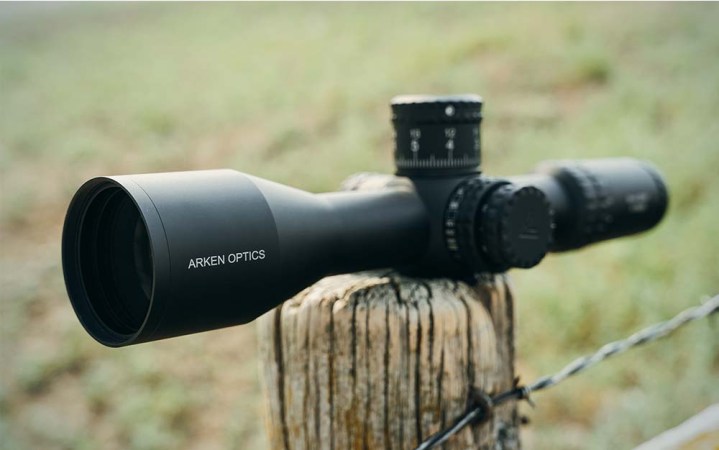
Every tester asked the same question as they put this precision scope through our battery of tracking and optical evaluations: Is that price a typo?
It’s a natural question, and even after confirming the price several times, it still seems unbelievable that a capable precision scope could cost so little. After spending months with this optic, the test team started to understand both its appeals and its limitations and concluded that it will give you years of use for the very accessible price. The Arken SH-4 Gen II was our consensus pick for our Great Buy award.
Let’s first talk about its appeals. It has a very serviceable Christmas tree-style milling reticle — Arken calls it its “VPR” in the first focal plane. The reticle has hash references on its main stadia and a series of dots for wind holds down to 12 MILs of elevation and 8 MILs on either side of the horizontal stadia. The reticle is fast and intuitive, and while some of the .25 MIL dots are pretty fine, we didn’t have trouble with visibility above about 7X.
The beefy exposed turrets have .1 MRAD click values. The elevation turret, with 35 MIL total internal adjustment, is zero-stopped. The unstopped windage turret has 14 MIL adjustment. We got 8 MILs of adjustment per revolution, which is a little less than the industry average.
The 6-step center-cross illumination is decent, and the parallax dials down to about 20 yards.
Now, for the disappointments. The glass in this scope is horrible. We detected peripheral distortion at just about every magnification, and there was so much flaring that we suspected some internal lenses were uncoated. That’s not the case — it’s fully multicoated — but it’s a hard scope to spend long periods behind. Most egregiously, we noted a significant smudge on one of the lens elements that’s nearly in line with the center of the reticle, making it hard to ignore.
The turrets are some of the worst in the field. They have positive clicks, but feel tinny, and there’s noticeable play in the travel.
Accepting a lower level of workmanship is one way that Arken can bring this scope to market at such an acceptable price. In the great scheme of things, though, we think that’s an acceptable bargain. We didn’t find any part of the build that worried us about its durability. And if there is a problem, buyers can be consoled by Arken’s “Worldwide Lifetime Warranty” that is fully transferrable and good for the lifetime of the optic. MSRP: $399; www.arkenoptics.com
Nightforce ATACR 4-20×50
Nightforce ATACR 4-20×50
We actually tested two Nightforce precision scopes, this class-leading iteration of the remarkable ATACR platform and a new configuration (2.5-20×50) of the equally remarkable NX8. But we put the ATACR through more iterations of our tracking and low-light battery and elevated this scope to our review.
This 4-20X version of the ATACR line fills a size and weight niche between the magnificently mammoth 5-26×56 F1 and the more compact AR-configured 4-16×42 F1. In a move that will probably raise eyebrows among some readers, we asked for an MOA-based sample with Nightforce’s MOAR F1 reticle, largely because that’s the model that we have the widest and deepest experience shooting. The ATACR is also available with the Horus TREMOR3, MIL-XT, and MIL-C reticle with MIL-based controls and holds.
Nightforce fans won’t find a lot new here, but for those who have never shot this optic, the controls are among the best in the business, with hardened turrets that turn with satisfyingly tactile precision. The brand’s zero stop sets the standard for the industry, and the parallax screws down to about 12 yards.
The 34mm tube contains 110 MOA (30 MRAD) of elevation adjustment and 80 MOA (23 MRAD) of windage adjustment. The ATACR tied for our best low-light performance, and we detected no optical aberrations. On the demerit side, we wish the eyepiece focus was a little less tight; most testers found it hard to focus the eyepiece independent of changing the magnification. But that’s a pretty petty quibble in an otherwise bombproof and professional scope.
That last adjective — professional — is an important one. At $3,000 this was easily the most expensive scope in our test — in fact, it is the most expensive optic in our test, regardless of type. It’s not for everyone. But if you’re a serious PRS shooter who needs to have the most reliable, repeatable controls and excellent glass, this is probably the scope you aspire to. MSRP: $3,000; www.nightforceoptics.com
Hawke Sidewinder 30 FFP 6-24×56
Hawke Sidewinder 30 FFP 6-24×56
Another accessibly-priced precision scope, this entry has tons of versatility for both rimfire and long-range centerfire target work. It’s also sized right for a wide variety of platforms, including hunting rifles.
We liked the light-delivery capabilities of the big 56mm objective, and the mounting dimensions of the 30mm tube. We also liked the relatively light weight of the 27-ounce Sidewinder. The extremely precise parallax focuses as closely as 10 yards and out to infinity. Just on the second-plane version of the Sidewinder (which we tested in our Versatile category), the red revolution indicator is a smart and clear way to determine elevation turret travel and should help shooters from getting lost in the turret.
We were dubious of the utility of the enclosed oversized parallax side wheel, but when we screwed it on the dial, it gave us great capability to easily focus far and near targets with ease. In fact, this was such a key asset that we wondered if it is the source of the scope’s name.
Of course, it wouldn’t be an Outdoor Life optics test without detailing a few disappointments. Hawke’s “Half Mil” reticle is nicely arranged, and the 6-step red illumination that lights up the entire middle half of the crosshairs is well done. But we wanted some numeric designations in the reticle, which features .5 MIL hashes on the axes and a series of plus signs for wind holds. As we riffed around a rimfire target course, we often had to stop and count down and out our holds. A couple of numeric references inside the reticle would make operation faster. We also wanted a zero stop on both turrets, but especially the elevation dial.
The pull-to-turn turrets tracked flawlessly, but we wanted a bit more positivity. The clicks are mushier than their peers in this class. And the limitations of the 30mm tube are evident in the relatively puny internal adjustment; both turrets have 20 MRAD of travel.
But, back to that appealing price. We used Hawke’s published retail price of $819 for our price/value consideration, but it’s worth noting that we found it selling online for $659, making it an even better option for an entry-level precision scope or a consideration for a cross-over target and hunting scope. MSRP: $819; www.us.hawkeoptics.com
Minox Long Range 5-25×56
Minox Long Range 5-25×56
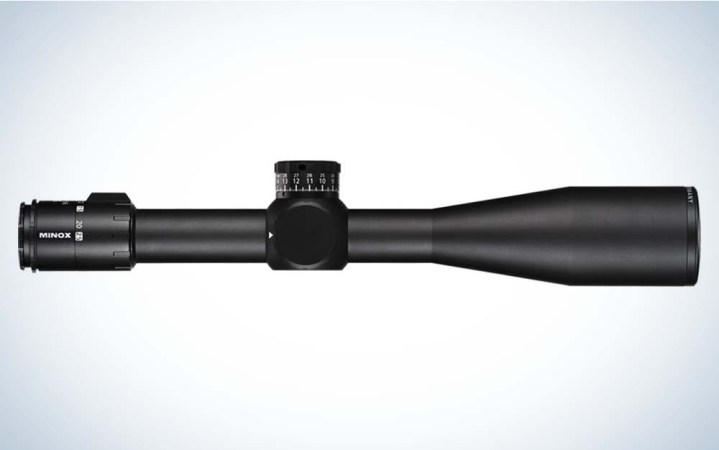
Minox finally produces a first-rate precision scope. This lovely, full-sized hammer has all the features you’d expect in a premium target scope: 34mm tube, first-plane milling reticle, ridiculously positive turrets tuned to .1 MRAD values, and magnification range that brings distant targets into tack-sharp focus and can dial down to provide great field of view and decent in-close acuity.
The glass was some of the best in the category, and the controls move with fluid positivity. The turrets turn with .1 MIL click values, and the elevation dial has 28 MILs of internal adjustment. We liked the 11-step reticle illumination and the smooth parallax control. The reticle is a hash-and-dot design that we found to be a bit too light. Speaking of reticle visibility, we found aiming points to be too faint at magnifications under 8X.
Two elements of this otherwise excellent scope hold the Minox back from its full capability. The controls and glass should put this in the same conversation as Kahles’ K525i and even Hensoldt’s premium scopes. But the reticle is simply too simple and fine to be visible against a wide variety of backgrounds.
And the zero stop adjustment is so convoluted that a couple of testers gave up, even after watching YouTube tutorials and exhausting the manual.
Still, the bones of this German-made optic are among the best in the test. If you’re looking for a classic precision scope with lovely lines and salty guts, this is a very good choice. MSRP: $1,999; www.minox.com
EOTech Vudu 5-25×50
EOTech Vudu 5-25×50
As with many of the scopes in our Precision field, this stubby Vudu is more of a product-line extension than a brand-new scope. The main advancement of the platform is the addition of the excellent Horus TREMOR3 reticle. Previous iterations of the 5-25 Vudu have had the MD3 hash reticle and Horus’s popular H59 reticle.
Longtime Optics Test readers may recall the first appearance of EOTech’s flagship magnified scope. We awarded the 1-6×24 Vudu our Editor’s Choice award when it was introduced back in 2017. A 1-8×24 version of the Vudu, with a second-plane reticle, did well in our test in 2019.
But this big tactical scope is a different Vudu, altogether. It has all the attributes of a classic precision scope: 34mm tube, locking pull-to-turn and zero-stoppable elevation turret with a bit over 34 MILs of elevation range and a useful revolution indicator, a very smart push-button illumination module, and sweet parallax control.
The glass is good, scoring nearly as high on our revolution test as the venerable Nightforce, though testers noted grainy images at the very highest end of the magnification range. Low-light performance was very good; the Vudu was the highest-scoring 50mm in the field. The biggest performance ding on the EOTech was that its eyebox is strangely stingy, meaning that the cheek weld had to be perfect in order to keep the eye in the exit pupil. If the head moved up or down or side to side, shooters had to struggle to retain the sight picture at magnifications over about 14X.
That tight eyebox may be due to the short stature of the scope. The test team had mixed reviews about its stature. The Vudu is one of the shortest first-focal plane scopes on the market, and one tester said he’d put the scope on a sheep rifle in order to take advantage of its crazy amount of reticle adjustment. Another thought it stubby and ungainly looking—with limited mounting dimensions. But one asset of its short design: you can easily add a night-vision or thermal device in front of the scope and still have room on the mounting rail.
In all, it’s a useful scope that fills a niche in the market, and for apostles of the TREMOR-style reticle, it’s a high-mag option that requires relatively little real estate atop your rifle. MSRP: $2,099; www.eotechinc.com
Bushnell Elite LRHS 4.5-18×44
Bushnell Elite LRHS 4.5-18×44
Another scope that splits the difference between hunting and target, this is the latest iteration in one of the pioneers of the entire precision scope category. Even the name — Long Range Hunting Shooting — gets at that crossover utility.
The noteworthy feature of this handy scope is the first-plane G2H milling reticle designed by the folks at GA Precision. In fact, this scope is available exclusively through GA Precision, as the house optic on their tack-driving rifles.
The attributes that we lauded in the first generation of the LRHS are present on this model. The exposed, platter-sized turrets tuned to .1 MIL values, the smooth magnification dial, this time supercharged with what Bushnell calls its “Throwhammer.” The elevation turret has 25 MILs of total adjustment and 10 MILs per revolution. The windage turret contains 22 MILs of adjustment.
The non-illuminated reticle, a circle/hash design, is fast and precise. The 2-MIL segmented center circle — Bushnell calls it the “Vital Bracket” — is designed to frame the breadbasket of big-game at known distances. The .25 MIL hashes are universally relevant no matter your load or platform.
We loved the glass in the Bushnell Elite. It’s clear, bright, and transmits colors without flaring or distortion, and Bushnell’s proprietary coatings are durable and protective. The mounting dimensions on the 30mm tube are liberal, and the 44mm objective allows for low-relief mounting.
The wide utility isn’t without its limitations. We had a hard time using the reticle references at magnifications under about 8X, and wanted the parallax to focus closer than its 50-yard limit. But for a scope that can easily transition from a big-game rifle to a steel-ringing GAP, this is a great all-rounder. MSRP: $949; www.bushnell.com
Athlon Ares ETR UHD 3-18×50
Athlon Ares ETR UHD 3-18×50
Just as we detailed with the other Athlon in this category, the Helos, this particular model has a kissing cousin in our Versatile Riflescope category. The main difference is in configuration, but it’s so different that we accepted them as two very different scopes that happen to have the same name.
The main difference is the configuration. This 3-18×50 version is perfectly suited for no particular task, which suppresses its precision score. But it’s so versatile for a number of target games and hunting scenarios that it scored pretty well on the all-around considerations. This scope shares the APLR6 MOA-based reticle of the Helos BTR, and because the magnification range is so similar, there aren’t meaningful distinctions between the two.
We measured two significant differences between the two precision Athlons. One is the controls. The Ares, at a price point a couple hundred dollars above the Helos, has smoother, more positive turret clicks. We found the parallax control, which focuses as close as 10 yards, to be tighter and more precise. And the 6-step illumination seemed both dimmer at the lower end and brighter at the upper end of the intensity scale. The Ares also has a better class of glass. While we noticed some aberrations with the Helos, the Ares glass is clear and bright and delivers an image with correct colors and contrast.
Just as we noted with the Helos, there are so many iterations of the Ares available, in a wide range of configurations that can be tuned to either MOA or MIL turret and reticle references, that there’s probably an Athlon for your particular preference and budget. MSRP: $999; www.athlonoptics.com
Sightmark Latitude 6.25-25×56
Sightmark Latitude 6.25-25×56
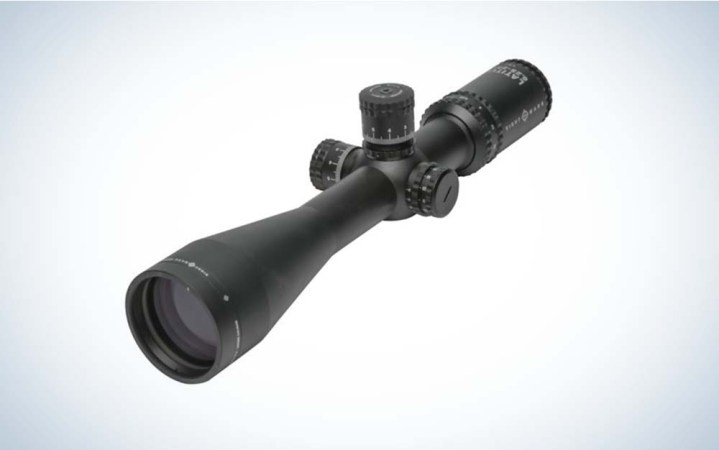
As we note in an accompanying video that profiles four accessibly-priced precision scopes, this full-service target optic provides everything a shooter needs for either rimfire or centerfire match work for right around $800.
The Latitude exhibits pretty much all the attributes of this category: 34mm tube, exposed turrets tuned to .1 MRAD click values, a milling reticle in the first focal plane, and precise parallax that brings targets as close as 20 yards into focus and alignment with the reticle. It has the bonus of Sightmark’s dual red and green illumination, useful for both daylight and night-vision capability.
The reticle, which Sightmark calls its “PRS,” gets at its utility and its, um, target market. This scope is squarely positioned to appeal to participants of the Precision Rifle Series. References area marked in .5 MIL increments on the windage and elevation axes, with .25 MIL windage dots, giving shooters plenty of aiming points no matter the distance or target type. The elevation turret has 31 MILs of internal adjustment; the windage dial has 20 MILs of turn; both move the reticle 10 MILs per revolution.
Operationally, we had very little complaints with this scope. Its turrets tracked nicely and mated up with the reticle. However, the glass disappointed testers. We found significant peripheral distortion and some color shifting. The turrets are softer and less distinct than many of its peers in this class, and while we liked the zero stop on the elevation turret, we wanted a similar mechanism on the windage knob.
With those assets and shortcomings, you can consider the Latitude a great entry-level precision scope. But it’s also one to consider for those interested in participating in the rise of rimfire matches. MSRP: $839; www.sightmark.com
Athlon Helos BTR Gen2 4-20×50
Athlon Helos BTR Gen2 4-20×50
Athlon has a very good problem. They have so many product lines and specific SKUs that customers can get confused by similar names and functions. Even within the same family name, performance features vary significantly or only slightly. Again, it’s a good problem to have, but it speaks to the second of two Athlon entries that bear the same name: the Helos BTR.
We have the 2-12×42 Helos in our Versatile test. We entered it in that category because the configuration seemed suited to a wide range of platforms. But we have materially the same scope in this Precision category that has many of the same features and controls. Why here? Because the 4-20×50 configuration seems more purpose-driven for a variety of target games.
The APLR6 reticle in our sample is tuned to MOA geometries and subtensions. It has tons of mid-range references that appeal to designated marksman duties, which require engaging targets between the close-encounter and sniper distances. At 4X, the reticle is perfectly visible and the 6-step illumination intensity is especially welcome. At 20X you still have nearly 30 MOA of drop visible on the horizontal stadia.
Just as with its lower-mag sister, this Helos has adequate but not especially crisp turrets. Similarly, the glass is adequate but we noted some blurring at higher magnifications. The parallax screws down to 20 yards, making it a good fit for rimfire use.
Bottom line: nothing especially groundbreaking about this scope, but it’s a solid-mid distance and priced-right workhorse. We should note that the Helos BTR is available in far more configurations than we’ve detailed here. So many that we won’t inventory them all here, but as you see the dizzying range of SKUs available from Athlon, you’ll start to see our challenge with categorizing their wide range of new optics
Things to Consider Before Buying a Long Range Rifle Scope
Precision rifle scopes are highly specialized optics. Because they’re designed to do one thing—place bullets precisely and consistently on targets at long range—they lend themselves to specialization. Unlike the best rifle scopes for hunting, where image clarity and brightness are the most important attributes, the things to consider in a long range rifle scope are the reticle and the controls, meaning the turrets. How usefully can you use the reticle to make shots where small mistakes are magnified by distance? Does the reticle have enough elevation and windage references? Is it a first-plane reticle, in which the references don’t change regardless of magnification?
How positive and precise are the turrets? Do they move the reticle the same 1 MIL of elevation at 500 yards that they do at 1,500 yards? Even the most affordable scopes should be able to do this routinely.
You should also consider the quality of glass. Do you notice any peripheral distortion? How about jags of light in full sunlight? Is the reticle sharp and distinct no matter the light conditions? Also consider illumination. Can you light up the reticle in full daylight conditions? And can you tamp down the illumination to make a subtle aiming point in low-light conditions?
All those—in pretty much descending order of priority—should be considered as you choose which precision rifle scope you’ll mate with your precision rifle.
FAQs
The best magnification for a long range rifle scope in the 3-18-power or the 5-25-power range. For 1,000-yard shots—which are frankly chip shots for the best precision shooters—you need enough magnification to see your target clearly and to place your first-plane reticle on the target. Either the 3-18-power or the 5-25-power models should do fine. A bigger perspective is whether you can stay in the scope as you make the 1,000-yard shot. You want to use the least amount of magnification possible, so that you can still stay in your scope and register your hit.
You can see all the way to tomorrow! Okay, that’s an exaggeration. Your long-range visibility depends a lot on conditions and your target. On hot days, when high magnification amplifies heat mirages, you may want to lower your magnification. But with the first-plane reticles in most of these precision rifle scopes, in most conditions you may want to increase your power so that your reticle references become more visible. Generally, our testers found that the most useful magnification range for a 5-25-power rifle scope is about 8-20-power. The additional magnification, on both the lower and higher ends, are nice features but may be too little—and too much—magnification for most shooters.
Just about any of the scopes in this group can make hits on 1,000-yard targets. But of course, it depends on the size of the target. For maddeningly small targets, you’re going to rely on precision features of your scope. Consider the finest reticle references, windage and elevation references in .1 MIL or .25 MOA. And you’ll want a reticle that shows all those fine references no matter the magnification, so a first-plane reticle is a must. You should also consider targets well inside 50 yards, the standard for precision rimfire matches. If you intend to shoot rimfire competitions, consider the fineness of the reticle and the close-in focusing capabilities of the parallax control.
Who makes the best rifle scopes in the world depends a bit on what you intend to use them for. For hunters who want a very clear, crisp image, even out beyond 400 yards, consider a European brand with best-in-class optics. But if you want a scope that can consistently place bullets on distant targets, consider a model with an excellent reticle, precise overbuilt turrets, and coatings that enhance both the target and the crosshair. And lastly, if you’re looking for a model that combines excellent optical glass, versatile crosshairs, positive turret movements, and useful illumination modules, look to the European brands such as Zeiss, Kahles, and Leica. But if you want decent glass and battle-proven controls plus an ironclad fully transferrable warranty, look to American brands such as Nightforce, Vortex, and Leupold.
How We Tested the Best Long Range Rifle Scopes
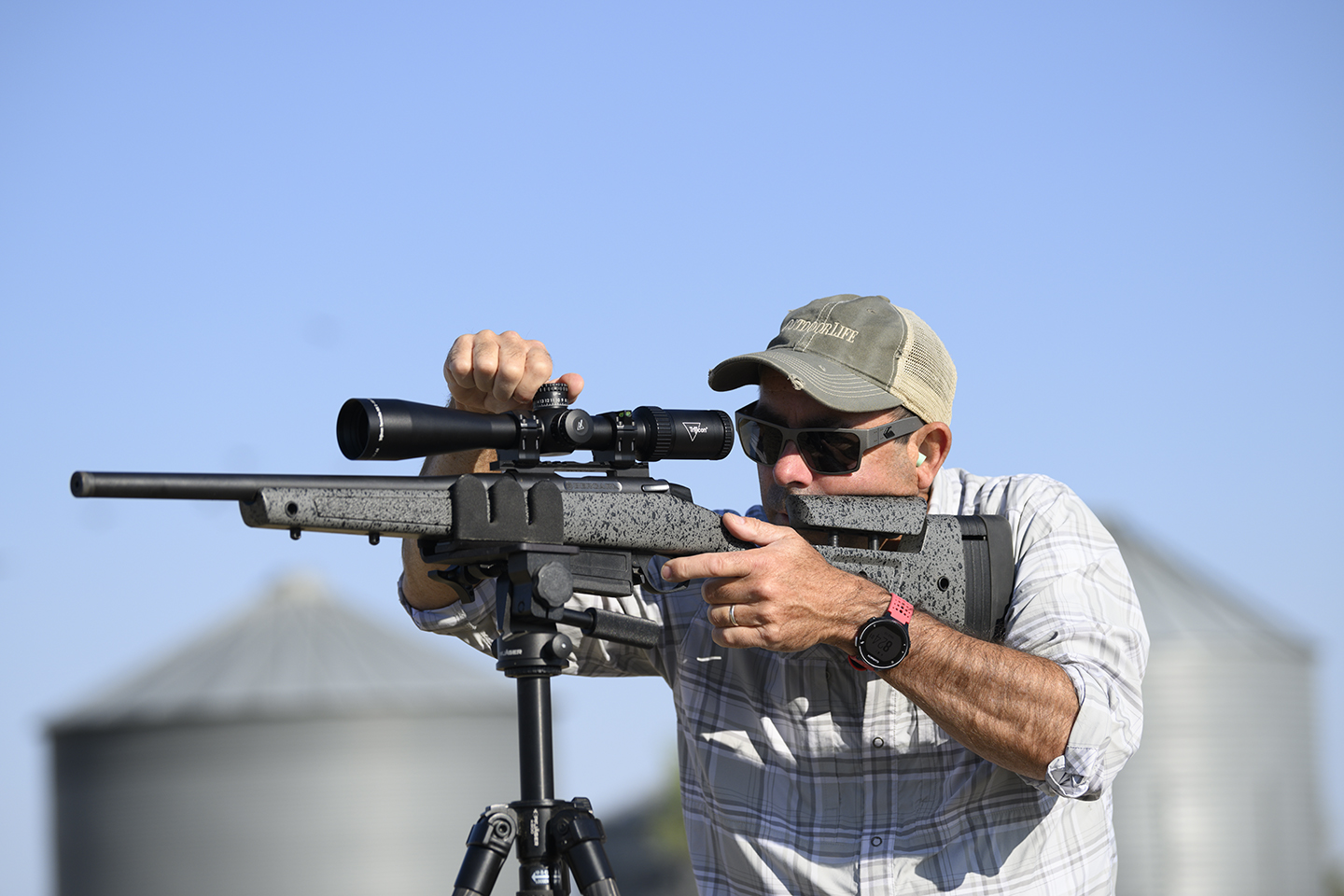
All the scopes in this particular group were submissions to the 2022 Outdoor Life optics test, which evaluates products introduced to the market in 2023 or the latter half of 2021. That’s why you don’t see some of your favorite models in this group; they’re no longer new. I started by measuring each submission’s optical resolution on my resolution range. Each scope is also measured on its low-light performance, which considers how far into the dark the scope can see a target, but also how visible the unilluminated reticle appears in low-light conditions.
Because these are precision aiming devices, I also measured the precision and repeatability of the reticle and turrets. We mount each scope to a precision .22 rimfire rifle and put it through a battery of targets, ranging from inside 25 yards to out to nearly 400 yards. At each distance, testers use reticle holds (windage and elevation) to make hits, but we also dial the turrets for each target and distance. That process informs testers how the reticle subtensions work, but gives us a feel for the precision and repeatability of the turrets. For each scope, testers make a subjective determination of optical quality, looking for distortions, optical aberrations, and any distracting jags of light. We determine how quickly and precisely we can use the reticle.
Lastly, we assess the extras, including the accessories that it ships with and each submission’s warranty. And we consider warranty terms. The scope that scores the highest overall wins our Editor’s Choice award—this year that goes to Zeiss’s excellent LRP S5. The scope that scores the highest Price/Value rating wins out Great Buy award. This year that goes to Arken Optics’ EP5.
Final Thoughts
Of all the categories in Outdoor Life’s optics test, the precision rifle scope class relies least on optical quality. These scopes are really precision aiming devices, so their ability to place bullets accurately and repeatedly across long distances are really their only job. With that in mind, we pay outsized attention to the reticle, turrets, and attributes such as zero stops, illumination, and parallax focus. Durability and warranty protection are also important considerations.
